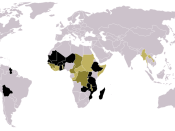PRSPOVERVIEW:The World Bank and International Monetary Fund (IMF) launched the concept of Poverty Reduction Strategy Paper (PRSP) in the autumn of 1999. It provides a framework that integrates nationally owned poverty reduction strategies in low-income countries.
These strategies are expected to be:÷Country-driven.
÷Results-oriented.
÷Comprehensive.
÷Have a long-term perspective.
÷Should foster domestic and external partnerships.
The PRSP was initially aimed to link the debt reduction of Heavily Indebted Poor Countries (HIPC), with a country-defined poverty reduction strategy.
PRINCIPLESThe principles at the root of PRSP are as follows:Ownership:Poverty reduction strategies must be country-driven, with a broad-based participation of civil society and private sector at all stages. The recipient government should be leading the program and must be held responsible for accounting the process.
Result-orientation:This is based on in-depth analysis of poverty; the strategies must identify the desired outcomes and the ways to reach them. They should be translated into process and outcome Indicators.
Comprehensiveness and long-term perspective:All the policies and Analysis must take account of the multidimensional nature of poverty and long timeframes necessary to reduce poverty.
Prioritization:Priorities must be chosen in order to design feasible policies and to adequately fund them.
Partnership:The process is to be based on dialogue and partnership between the government and civil society as well as the donor community implementing good donor coordination. This allows reduced transaction costs and more efficient aid.
The process proceeds by an initial in-depth and comprehensive analysis of the country's poverty and its determinants. This helps in conceiving a prioritized mix of strategies that have the highest impact on poverty reduction that can be tracked through key outcome indicators.
The PRSP should be prepared every three years, with regular monitoring and reporting on progress and annual updating of the strategies. The approach starts with designing an Interim PRSP (I-PRSP). I-PRSP is necessary...


